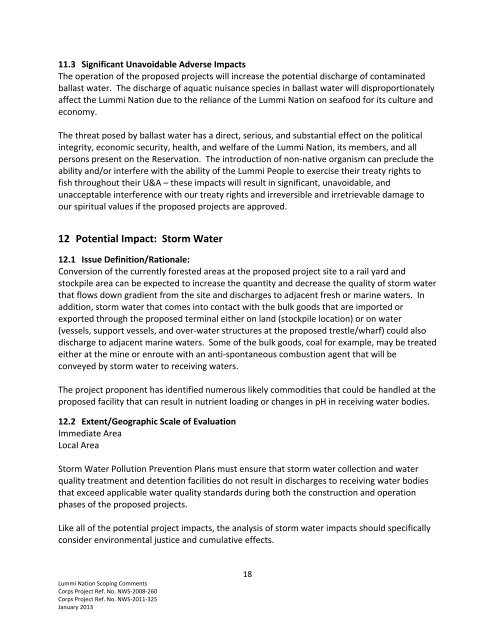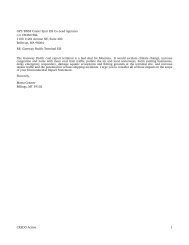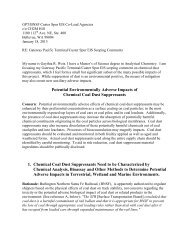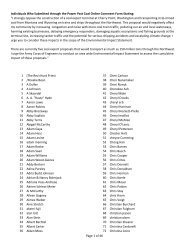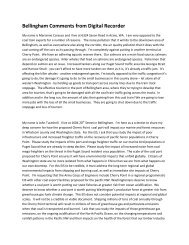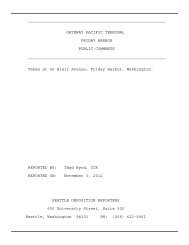Lummi Indian Business Council - EISs for the Proposed Gateway ...
Lummi Indian Business Council - EISs for the Proposed Gateway ...
Lummi Indian Business Council - EISs for the Proposed Gateway ...
You also want an ePaper? Increase the reach of your titles
YUMPU automatically turns print PDFs into web optimized ePapers that Google loves.
11.3 Significant Unavoidable Adverse ImpactsThe operation of <strong>the</strong> proposed projects will increase <strong>the</strong> potential discharge of contaminatedballast water. The discharge of aquatic nuisance species in ballast water will disproportionatelyaffect <strong>the</strong> <strong>Lummi</strong> Nation due to <strong>the</strong> reliance of <strong>the</strong> <strong>Lummi</strong> Nation on seafood <strong>for</strong> its culture andeconomy.The threat posed by ballast water has a direct, serious, and substantial effect on <strong>the</strong> politicalintegrity, economic security, health, and welfare of <strong>the</strong> <strong>Lummi</strong> Nation, its members, and allpersons present on <strong>the</strong> Reservation. The introduction of non‐native organism can preclude <strong>the</strong>ability and/or interfere with <strong>the</strong> ability of <strong>the</strong> <strong>Lummi</strong> People to exercise <strong>the</strong>ir treaty rights tofish throughout <strong>the</strong>ir U&A – <strong>the</strong>se impacts will result in significant, unavoidable, andunacceptable interference with our treaty rights and irreversible and irretrievable damage toour spiritual values if <strong>the</strong> proposed projects are approved.12 Potential Impact: Storm Water12.1 Issue Definition/Rationale:Conversion of <strong>the</strong> currently <strong>for</strong>ested areas at <strong>the</strong> proposed project site to a rail yard andstockpile area can be expected to increase <strong>the</strong> quantity and decrease <strong>the</strong> quality of storm waterthat flows down gradient from <strong>the</strong> site and discharges to adjacent fresh or marine waters. Inaddition, storm water that comes into contact with <strong>the</strong> bulk goods that are imported orexported through <strong>the</strong> proposed terminal ei<strong>the</strong>r on land (stockpile location) or on water(vessels, support vessels, and over‐water structures at <strong>the</strong> proposed trestle/wharf) could alsodischarge to adjacent marine waters. Some of <strong>the</strong> bulk goods, coal <strong>for</strong> example, may be treatedei<strong>the</strong>r at <strong>the</strong> mine or enroute with an anti‐spontaneous combustion agent that will beconveyed by storm water to receiving waters.The project proponent has identified numerous likely commodities that could be handled at <strong>the</strong>proposed facility that can result in nutrient loading or changes in pH in receiving water bodies.12.2 Extent/Geographic Scale of EvaluationImmediate AreaLocal AreaStorm Water Pollution Prevention Plans must ensure that storm water collection and waterquality treatment and detention facilities do not result in discharges to receiving water bodiesthat exceed applicable water quality standards during both <strong>the</strong> construction and operationphases of <strong>the</strong> proposed projects.Like all of <strong>the</strong> potential project impacts, <strong>the</strong> analysis of storm water impacts should specificallyconsider environmental justice and cumulative effects.<strong>Lummi</strong> Nation Scoping CommentsCorps Project Ref. No. NWS‐2008‐260Corps Project Ref. No. NWS‐2011‐325January 201318


